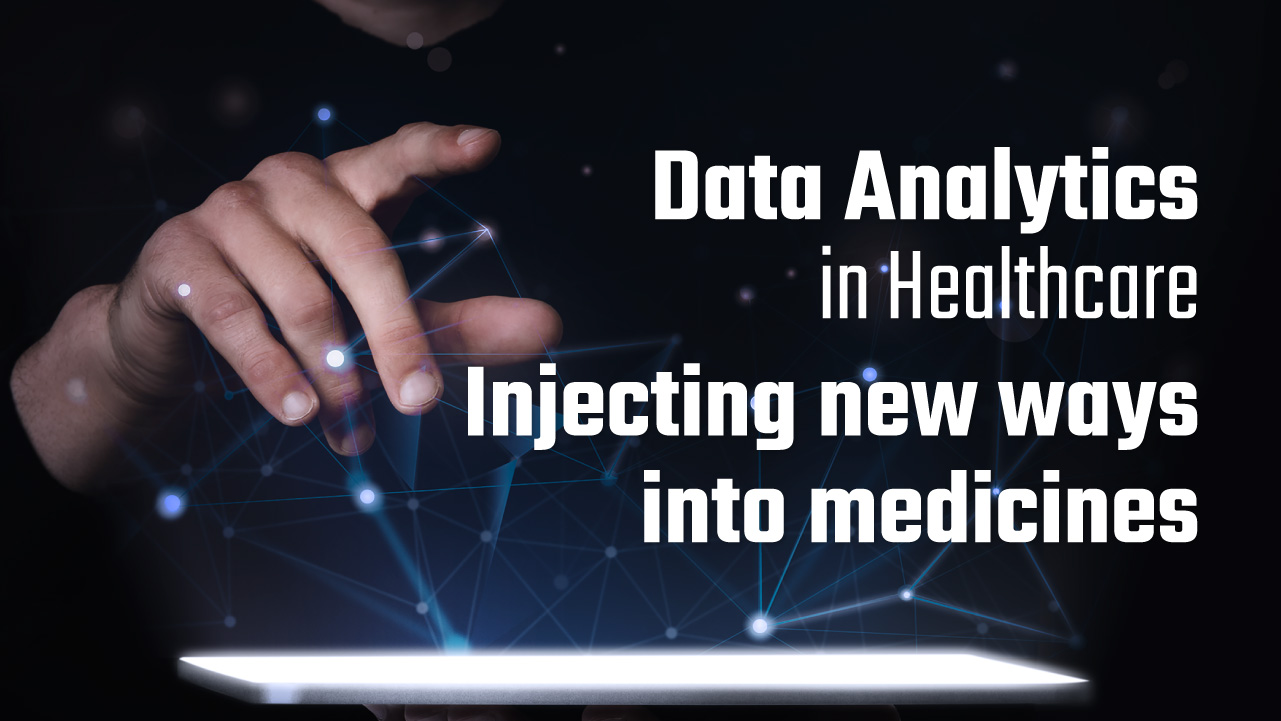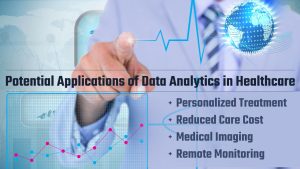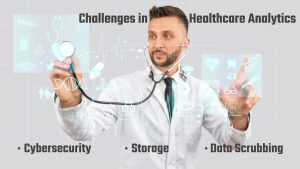
As it is said, data is everywhere. But what is data? Data is raw information. Data is the numbers, letters, or symbols a computer performs operations on; these can be recorded on magnetic, optical, or mechanical recording media and stored and transferred as electrical signals. In simple terms, information converted into a format useful for movement or processing is known as data.
If the collection of raw information is data-what is analytics? Data analytics is the practice of examining unstructured data to get valuable, practical insights utilized to guide and motivate wise business decisions.
Ok, now what is Healthcare? A place where we get ourselves treated when we are ill. Nope! It is everything surrounding the businesses that offer medical services, produce medical supplies or medications, offer medical insurance, or in some other way help patients receive healthcare make up the healthcare sector.
Now, how do all these come together, and how will they influence the future world? Together they form a word rather world of Healthcare Analytics.
As we already discussed, the healthcare industry is full of information like prescriptions, medical history, billing, reimbursements, insurance, etc. A Healthcare Analytics solution can be defined as a specialized technology solution needed to evaluate all of this data regarding daily operations and thousands of patients. Healthcare analytics solutions, as their name suggests, enable the medical sector to gain important insights from the data and apply them to raise the standard of treatment. Healthcare analytics includes clinical care patterns and financial patterns.
The industry-wide high speed of digitalization is to blame for the creation of such enormous data sets in healthcare. Along with smart clothing, medical wearables like Fitbit and Apple’s smartwatch also produce real-time data regarding users’ vitals. The size of this data will only grow as digitization rates rise. If this data can be handled, it surely offers a gold mine of useful insights about public health that can be put to use. Advanced big data analytics for healthcare can address the nation’s most pressing health difficulties as well as several business issues.
Ok, so the point is that big data is the next big thing in the healthcare industry. But what kind of problems does it address in real?
- Opioid Abuse: The amount of opioid abuse-related deaths worldwide is comparable to the numbers one would typically observe in an epidemic. Doctors and medical researchers concur that immediate government engagement is required to address this health issue. The vast amounts of data that the healthcare sector produces could hold the key to solving this issue. Using information from insurance payers and pharmacies, healthcare data analytics solutions have discovered hundreds of risk indicators that may predict if a person is prone to develop opiate misuse. With this understanding, medical professionals such as doctors and therapists have started devising interventions to reach out to such people and stop the abuse.
- Predictive Analytics: The use of healthcare analytics can identify individuals who may be more susceptible to developing specific illnesses. Medical informatics advancements have shown the potential to analyze historical and present medical data from millions of patients to identify illness patterns. This method of big data processing establishes an acceptable risk threshold by learning from millions of medical records. When a person has crossed the threshold, the system can determine whether they are likely to have the ailment for which the threshold was set. To be more specific, depending on lifestyle choices and medical history, predictive analytics can identify those who are more likely to contract particular diseases. This is hailed as a game-changer for the sector because it has the potential to significantly lower total healthcare costs and contribute to the prevention of chronic diseases.
- Engagement: One of the most underappreciated areas of medical treatment that few people like to talk about is patient engagement. Many patients require ongoing communication with their doctors since they can not manage their care. It is especially true for those who have chronic illnesses and require regular checkups and follow-up appointments. Patients frequently have questions about their prescription regimens, dosages, procedures, tests, scans, or outcomes. There is an avalanche of health data due to the introduction and widespread use of commercial wearables and other IoT-driven health tech. Analyzing this data provides crucial insights into the patient’s physical health. Even better, it can forecast some people’s health risks, allowing clinicians to plan effective interventions at the right time.
- Staffing: Doctors, nurses, orderlies, and other administrative employees make up a substantial portion of the workforce that large hospitals frequently have to manage. Hospitals may be understaffed or overstaffed depending on the admittance rates, which frequently vary. The former is detrimental to patient care, whereas the latter would cost the hospital more money in overtime. But over time, large data gathered from patient electronic health records, insurance claims, billing activities, admissions, discharges, and other sources can assist solve the staffing efficiency issue. Administrators and staff managers can make the best use of their human resources by having a solid notion of how many employees they will need at any particular time.
Potential Applications of Data Analytics in Healthcare
Too many potential uses exist for big data analysis to be covered in a single discussion. A growing number of new insights are also found every year. It is understandable why the data analytics sector has attracted hundreds of millions of dollars in venture capital funding to support advances. Over this, start-ups have expanded and entire enterprises have been created.
- Personalized Treatment: Since no two persons are alike, different people have diverse reactions to the same therapies. While some people may recover after receiving a course of treatment and go back to living their lives in a matter of days, others may not be as fortunate. According to a person’s medical history, the current state of health, genetic disposition, allergies, and other circumstances. As a result, healthcare providers may now examine a patient’s natural body constitution and develop a customized treatment plan that is specific to each individual thanks to advancements in analytical technologies. One of the most discussed parts of healthcare is personalized medicine, which many people view as one of the major developments to look forward to. It has generated excitement among many regular people and in medical circles. Many studies have even claimed that it might transform medicine as we currently know it. Personalized medicine may change the one-size-fits-all philosophy that has been the foundation of conventional care since its inception.
- Reduced Care Cost: Like any other business, hospitals eventually rely on their income. Although giving care may be the top priority, doing it profitably is crucial. Advanced analytics for the healthcare industry can analyze operational and administrative data from routine hospital workflows to determine which tasks consume the majority of the resources. The senior management can take action to optimize things once they are aware of this. Efficiency can be evaluated in healthcare areas such as billing, coding, insurance claims, managing inventory, supply chains, vendors, and other operational expenses. Then, to emphasize what can be done, healthcare IT analytics reveals significant trends concerning all operations. This makes it possible for administrators to decide on optimization with knowledge. Automation in the healthcare industry is one of the most widely used solutions to this issue. As implied by the name, it automates manual, repetitive operations to boost efficiency and reduce errors. As a result, hospitals may see a decrease in the price of healthcare, which will increase their income.
- Medical Imaging: X-rays, CAT scans, MRIs, CT scans, and other types of medical imaging are included. It typically takes some time to evaluate these photos, and doing so manually could lead to the early detection of some medical issues. When the cancer is in its early stages, the tumours in some cases were too small for doctors to detect. However, by processing a large number of scans, healthcare analytics solutions driven by cutting-edge technology like artificial intelligence and machine learning can learn to analyze images more quickly. These algorithms improve their disease detection capabilities by learning from hundreds of thousands or even millions of medical scans.
- Remote Monitoring: Remote patient monitoring entails keeping an eye on patients away from typical clinical settings. Home care and senior living facilities are two examples of this. Knowing if a person is susceptible to any medical emergencies can be determined by analyzing data obtained from medical devices such as electrocardiograms, glucose monitors, and medical wearables. That’s because current medical issues can be highlighted in real-time health data that has been gathered over time and properly analyzed without the need for a person to visit a clinic. Since there won’t be enough caregivers to care for the millions of seniors who will be living alone by the end of this decade, this could show to be quite helpful for senior care. Elder care can be improved by using remote patient monitoring powered by healthcare data analytics.
Challenges in Healthcare Analytics
- Cybersecurity: The biggest corporations in the world are spending millions to secure their data against cybercrime, which is an increasing threat in the contemporary digital age. Given the high value of personal information on the black market, hackers have become more daring in their attacks. Because of this, healthcare institutions place a high focus on protecting patient data. The security of the datasets from dishonest people is becoming more difficult as they grow in size. Solutions that are HIPAA-compliant have become crucial to health technology. The HIPAA rules must be followed for everything, including medical records, practice management software, insurance verification, billing, and claims. Data loss can occur due to human error as well as cyberattacks. Digital security can be threatened by incidents like laptop theft, smartphone hacking, unintentional sharing of credentials with the wrong persons, or even corporate espionage.
- Storage: As was already noted, the increased digitization of the healthcare sector can only mean more data being produced and distributed. Additionally, the growing acceptance of IoT-driven medical devices produces regular health data on hundreds of millions of individuals. With each year that goes by, the amount of medical data being produced grows exponentially. Therefore, the effective administration and storage of this mountain of data is the first thing that comes to mind. The firm will no longer be able to store all of this data on-premises in the future due to the overwhelming hardware and network bandwidth needs. Many healthcare organizations are employing third-party suppliers’ services and moving their data to the cloud. For daily operations, the majority of hospitals use integrated healthcare systems, and they frequently use a hybrid approach to storage. However, the medical and IT groups are quite concerned about the rate at which the volume of data is growing.
- Data Scrubbing: The quality of the data is a significant issue that needs to be addressed, even while the expanding bulk of the data has caused storage concerns. Quality here refers to the data’s suitability for use in clinical analytics. Electronic records, insurance claims, health plans, medical billing, and even medical wearables are just a few of the disparate sources from which healthcare data is gathered. Data must be accurately checked, catalogued, and kept in a specific way. It resembles methodically placing hundreds of volumes in a library. The information also needs to be correct, pertinent, and uncorrupted. By doing this, programs for analyzing healthcare data are guaranteed to be able to generate the necessary insights. Scrubbing the data refers to organizing the data and ensuring that it is suitable for analytical procedures. Scrubbing is difficult because of its enormous volume and quick expansion. Because datasets are getting bigger, traditional scrubbing techniques are becoming less effective.
Data is the engine that drives productivity and growth across all industries, and it can do wonders for patient care while simultaneously lowering costs in the healthcare sector. The amount of data that needs to be handled will inevitably grow as the sector continues to adopt digital technology on an annual basis. To fulfill the rising demand, healthcare analytics solutions must therefore advance.
The use of data analytics in healthcare has already had a significant impact on healthcare professionals’ capacity to provide patients with high-quality care in an effective, efficient manner. However, the importance of data analytics in improving patient outcomes and healthcare systems continues to grow and extend as more types of data become available and new technologies are developed that make the analytics results clear and easy for healthcare personnel to use. Realizing the potential of data analytics to alter the healthcare sector requires an understanding of how the technology may be used to address issues encountered by healthcare providers, such as staff recruitment and utilization, operational efficiencies, and improved patient experiences. The key to gaining access to this crucial knowledge is data analytics.

